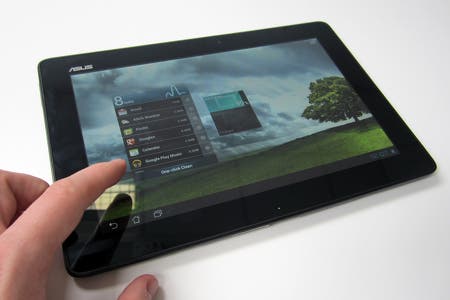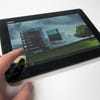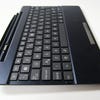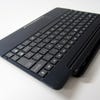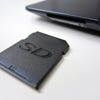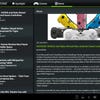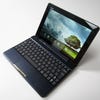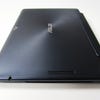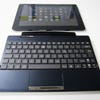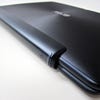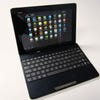Asus Transformer Pad TF300 Review
The Transformer Prime's Tegra 3-powered little brother gets the Digital Foundry treatment.
Google has had its nose blooded by Apple on more than one occasion in the tablet arena. Despite a seemingly endless stream of 'iPad beaters' bearing the Little Green Android logo, none have really come close to matching the irresistible commercial and critical performance of Apple's world-beating slate.
Still, a select few of Google's hardware partners have proven that it's possible to find success in the shadow of a dominant rival, and Asus is one such firm. Its Transformer Prime tablet/netbook hybrid has sold particularly well - in Android tablet terms, at least - and in many respects provides a deeper and more engaging user experience than that of the iPad, thanks to its delightful keyboard dock.
However, at £500 - when purchased in conjunction with the dock - the Transformer Prime isn't cheap, and Asus is clearly aware of this fact. The arrival of the Transformer Pad TF300 aims to address this issue, taking the form of a reasonably-priced alternative, boasting largely the same arrangement of internal tech while shaving £100 off that problematic RRP.
It only takes a quick once-over of the Transformer Pad TF300's external casing for it to become immediately apparent where Asus has cut costs on this device; while the Transformer Prime was clad in gorgeous, shiny aluminium, its low-cost relative opts for cheaper plastic attire. This invariably makes the TF300 feel a little less luxurious, but this is an issue which proves concerning for no more than a few minutes. Despite the cheaper materials, the construction of this tablet is equally as robust as its more illustrious forerunner.
The same cannot be said of the keyboard dock, sadly. Although the hinge mechanism is fashioned from metal, the rest of the dock is plastic, but it doesn't feel as solid as the tablet. When fused together, the entire arrangement feels a bit top-heavy, and you'll often find that the keyboard lifts up because of the weight of the tablet itself. This issue impacted the Transformer Prime to a certain extent, but not as badly as it does here.
The placement of the rubber feet on the bottom of the dock may also be a contributing factor; when laid on a desk, only the front feet actually make contact with the surface, whereas the rear ones are lifted up thanks to the position of the aforementioned hinge. Without that additional purchase, the whole setup feels a little unstable at times.
Weight distribution grumbles aside, the dock adds a massive degree of functionality to the package, as well as turning the device into a fully-fledged laptop. There's a USB 2.0 port (sadly not dual ports, as seen on the first Eee Pad Transformer TF101), into which you can plug a mouse, USB thumb drive or even an Xbox 360 or PlayStation 3 joypad - Android 4.0 has gamepad support out of the box.
There's also an SD card slot, which complements the microSD port on the main tablet and serves as an additional expansion option in case you feel that 32GB of internal memory isn't sufficient. Both the dock and the tablet itself use a proprietary charging port, which is a shame, as we'd like to have seen support for the MicroUSB standard, as was the case on the Motorola Xoom 2. Finally, it's worth remembering that the dock has its own internal battery, and the combined tablet/dock combo is good for around 15 hours of continuous usage. On its lonesome, the TF300 manages about 9-10 hours on a single charge.
Another area where Asus has reduced costs is the screen. The IPS panel is the same size (10.1-inches) and resolution (1280x800 pixels) as the one seen on the Transformer Prime, but the difference is that it lacks the 'plus' rating. The display on the more expensive model is brighter and easier to ascertain in direct sunlight; the one on the Transformer Pad TF300 sadly lacks the same impact, but still offers excellent image quality and good horizontal and vertical viewing angles.
Featuring Android 4.0
The Transformer Pad comes with Android 4.0 (aka Ice Cream Sandwich) installed. It's the most recent version of Google's mobile OS, but is soon to be overtaken by Android 4.1 - codenamed Jelly Bean, which launches in mid-July. Given that Jelly Bean is more of an enhancement than a full-blown revolution, it's reasonable to expect that the Transformer Pad will get a firmware update before the end of the year. Asus has a decent track record for updating its devices to new versions of Android, unlike some of its competitors.
"The IPS panel in the TF300 isn't as bright or impactful as the screen in the Transformer Prime, but still offers excellent image quality and impressive viewing angles."
Although the external appearance of the Transformer Pad is a lot less impressive then the Transformer Prime, when you delve into the underlying tech you'll find some striking similarities. The Tegra 3 SoC which powers the Prime is in evidence here, too - albeit clocked at a slightly lower speed.
The quad-core Tegra 3 T30L inside the Transformer Pad operates at 1.2GHz and can be pushed up to 1.3GHz when using just a single core. By way of comparison, the more muscular Prime uses the T30 variant of the chipset and boasts 1.4GHz speed at the top level, rising to 1.5GHz when only one of the cores is active. The chipset inside the Transformer Pad also has a slightly less powerful graphics processor - a 416MHz ULP GeForce compared to the 520 MHz variant in the Prime.
Technical Performance and Gaming
While it can't match its big brother in terms of raw specifications, the Transformer Pad still comfortably wipes the floor with most other Android slates. We ran the tablet through the usual gauntlet of benchmark tests, and it came out with very impressive scores - in many cases, it more than doubled the scores of its immediate forerunner, the Eee Pad Transformer TF101.


Of course, this level of power makes the Transformer Pad an ideal candidate for mobile gaming. The tablet comes preloaded with NVIDIA's TegraZone application, which highlights all of the optimised games currently available, as well as samples of forthcoming exclusives.
While there's a respectable selection of Tegra 3 releases, a large number of pre-existing Android titles now benefit from enhanced power supplied by NVIDIA's chipset. For example, Max Payne Mobile on the TF300 has noticeably superior lighting effects when compared to the same game running on non-Tegra hardware, and third-person shooter Shadowgun boasts similar aesthetic embellishments. Encouragingly, both games also allow you to plug in a USB pad for a more authentic gaming experience - this is fast becoming the norm for intense 3D games on Android.
Other titles are slightly less impressive from a gameplay perspective, but give a solid indication of just how much raw power resides within NVIDIA's hardware. On-rails House of the Dead clone Renaissance Blood THD is as shallow as a puddle but looks astonishing when compared to the vast majority of games currently available for Android phones and tablets.
"Max Payne Mobile and Shadowgun allow you to plug in a USB pad for a more authentic gaming experience - this is fast becoming the norm for intense 3D games on the Android platform."
Camera Quality and Sample Shots
We've always found the idea of having a camera on a tablet as somewhat pointless, and Google's decision to omit a rear-facing snapper from the shiny new Nexus 7 suggests that photography isn't a pressing concern with this kind of device. Nevertheless, the Transformer Pad comes equipped with the same 8-megapixel sensor that found its way into the Transformer Prime, and offers comparable results.
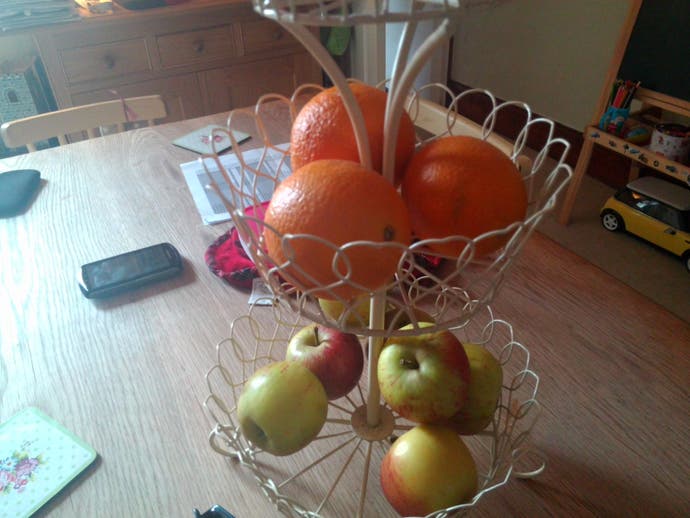

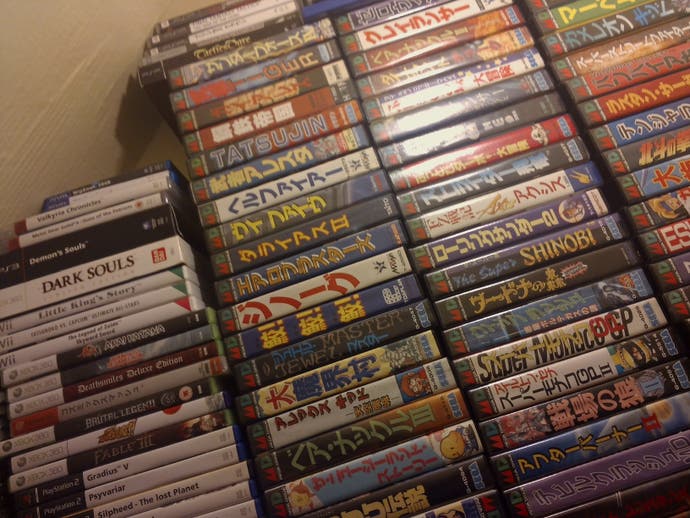

The lack of an LED flash means that low-light pictures are difficult to take, and the sensor struggles in situations where you've got a combination of extreme light and dark areas. In an attempt to capture the scene, the camera has a tendency to overexpose, resulting in a light bloom effect which makes it appear as if the lens is smeared with vaseline. Fine if you're going for the 1970s Penthouse Magazine look, but not so great if you want sharp and defined images. The inclusion of 1080p video recording makes the tablet a half decent substitute for your handycam - albeit on a strictly temporary basis.
Asus Transformer Pad TF300: The Digital Foundry Verdict
With the Transformer Prime already available in stores for £100 more and the Transformer Infinity TF700 waiting in the wings, the Transformer Pad isn't going to be particularly appealing to those buyers who strive for high-end performance and luxurious construction. Asus clearly intends for this device to be its entry-level tablet/netbook combo, and in that respect it's better suited to those individuals who have glanced longingly at the Transformer Prime but recoiled in horror at the £500 price tag.
"iPad 2 is around £100 cheaper and remains the more impressive tablet from a games perspective, but the Transformers sell based on all-round performance and functionality - and the TF300 doesn't disappoint."
Of course, the real rival in the tablet arena is Apple, and when you consider that you can get an iPad 2 for around £100 less and an iPad 3 (or New iPad, if you will) for around the same price, the Transformer Pad seems a little less of a bargain.
Of course, neither of those two alternatives can offer a keyboard dock or the expanded functionality of Asus' challenger, so it really boils down to what you want from your tablet device. Once upon a time, we'd have had no issue with wholeheartedly recommending the iPad over all its rivals, but Android is becoming a very solid alternative - both at the low end (thanks to the recently unveiled Nexus 7) and at the high end, where the Transformer Pad and its siblings reside.
